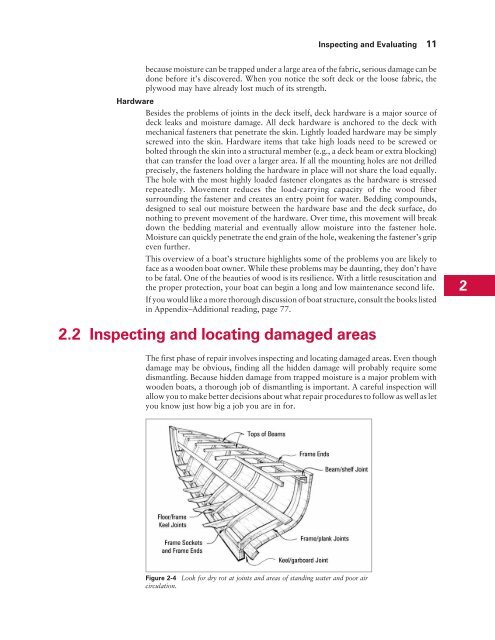Wooden Boat Restoration Repair - WEST SYSTEM Epoxy
Wooden Boat Restoration Repair - WEST SYSTEM Epoxy
Wooden Boat Restoration Repair - WEST SYSTEM Epoxy
Create successful ePaper yourself
Turn your PDF publications into a flip-book with our unique Google optimized e-Paper software.
ecause moisture can be trapped under a large area of the fabric, serious damage can be<br />
done before it’s discovered. When you notice the soft deck or the loose fabric, the<br />
plywood may have already lost much of its strength.<br />
Hardware<br />
Besides the problems of joints in the deck itself, deck hardware is a major source of<br />
deck leaks and moisture damage. All deck hardware is anchored to the deck with<br />
mechanical fasteners that penetrate the skin. Lightly loaded hardware may be simply<br />
screwed into the skin. Hardware items that take high loads need to be screwed or<br />
bolted through the skin into a structural member (e.g., a deck beam or extra blocking)<br />
that can transfer the load over a larger area. If all the mounting holes are not drilled<br />
precisely, the fasteners holding the hardware in place will not share the load equally.<br />
The hole with the most highly loaded fastener elongates as the hardware is stressed<br />
repeatedly. Movement reduces the load-carrying capacity of the wood fiber<br />
surrounding the fastener and creates an entry point for water. Bedding compounds,<br />
designed to seal out moisture between the hardware base and the deck surface, do<br />
nothing to prevent movement of the hardware. Over time, this movement will break<br />
down the bedding material and eventually allow moisture into the fastener hole.<br />
Moisture can quickly penetrate the end grain of the hole, weakening the fastener’s grip<br />
even further.<br />
This overview of a boat’s structure highlights some of the problems you are likely to<br />
face as a wooden boat owner. While these problems may be daunting, they don’t have<br />
to be fatal. One of the beauties of wood is its resilience. With a little resuscitation and<br />
the proper protection, your boat can begin a long and low maintenance second life.<br />
If you would like a more thorough discussion of boat structure, consult the books listed<br />
in Appendix–Additional reading, page 77.<br />
2.2 Inspecting and locating damaged areas<br />
Inspecting and Evaluating 11<br />
The first phase of repair involves inspecting and locating damaged areas. Even though<br />
damage may be obvious, finding all the hidden damage will probably require some<br />
dismantling. Because hidden damage from trapped moisture is a major problem with<br />
wooden boats, a thorough job of dismantling is important. A careful inspection will<br />
allow you to make better decisions about what repair procedures to follow as well as let<br />
you know just how big a job you are in for.<br />
Figure 2-4 Look for dry rot at joints and areas of standing water and poor air<br />
circulation.<br />
2
















